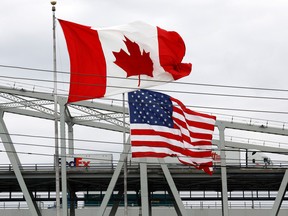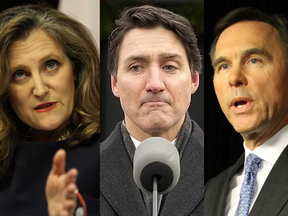Carlo Dade: Canada must find ways to advance U.S. priorities if it wants sway in Washington as trade pact comes up for renewal
Article content
On its most important foreign policy issue Canada is sleepwalking into trouble once again.
With U.S. election season heating up and the first regularly scheduled review of the new North American trade agreement two years out, governments, business and media are increasing focus on efforts to engage the United States.
Article content
Being proactive should be good news, but it is not.
Advertisement 2
Article content
The lessons of engaging an evolving Trump/MAGA United States are not being applied to the underlying framework of engagement — the choice of issues to discuss, how they are framed, the language that is used and the partners with whom Canada works all need an update. To not do so is to engage in an alternate reality, a past that no longer exists.
MAGA does not stand for Make North America Great Again
Daily examples of how the U.S. has changed are of course as clear as they are impossible to miss for the public. How these changes affect Canada, though, is less clear.
Rationality, predictability, treating allies with respect and the defence of rules-based trade on which Canada depends, are now the exception instead of the norm in Washington. Canada’s traditional allies there, those who have not abandoned politics or passed on, are marginalized and weakened. The U.S. foreign policy establishment upon which Canada relies has lost credibility outside of the Washington bubble and is a political liability. Former bastions of traditional conservatism like the Heritage Foundation now question aid for Ukraine and are MAGA warriors. Ronald Reagan surely now spins in his grave.
Article content
Advertisement 3
Article content
Starting with the Obama era, the traditional, reflexive appreciation for the Canada-U.S. relationship has no longer been a starting point for conversations in political circles south of the border. Canada’s position has not recovered under Biden, and under a new Trump, or any Republican, administration it will get worse, starting, potentially, with an across-the-board 10 per cent tariff on all imports into the U.S. that is already being threatened.
Canada must change its approach to adapt to this new reality.
That starts by not continuing to try to convince Americans that issues important to Canada, like bilateral trade, matter to the U.S. The standard playbook for outreach to the U.S. invariably flaunts Canada as the top trade partner for 19 U.S. states, more states than China and Mexico combined. The assumption is that this is as important for the U.S. as for Canada.
It’s not. Trade is two-thirds of Canada’s GDP; for the U.S. it is roughly one fifth.
Take Alberta. Over 33 per cent of GDP comes from exports of which 90 per cent go to the U.S. Next door in Montana, only four per cent of GDP comes from exports of which less than half go to Canada. The story is similar along the border. While trade is important for states, it’s just not nearly as important as for provinces. It’s certainly not the foundation upon which to anchor an advocacy campaign — MAGA does not stand for Make North America Great Again.
Advertisement 4
Article content
Defending trade with the U.S. means framing it in terms that put America, not our mutual benefit, first.
The trade issue that is important to Americans is the trade war with China, which the U.S. views as an existential threat. This is a federal priority that resonates with U.S. states. Framing Canada-U.S. trade wholly in the context of the American priority to reshore trade instead of the old “win-win” language is the type of change in language and approach needed across the board.
But words alone are not enough.
Canada has contributed platitudes and policy alignment but little hard cash to things of mutual interest, let alone things that are important to the U.S. Instead of (proportionally) matching U.S. Inflation Reduction Act (IRA) infrastructure money with a Canadian program, government and business complained, loudly, that Canada was barred access to U.S. taxpayer IRA money. Technically Canada’s complaints were well founded. But being right did not help us: instead, it drew attention to our freeloading.
A better approach would be to offer Canadian money to build stronger North American supply-chain infrastructure to compete with China and enable near-shoring. According to the Parliamentary Budget Office, Canada has close to $19 billion in projected unspent funds at the Canada Infrastructure Bank. It’s not the US$240 billion that Australia is spending on submarines to help the U.S. with the defence of the Pacific, but any significant Canadian contribution will help change the view in the states is that Canada freeloads on U.S. taxpayers while hoarding its own money.
Advertisement 5
Article content
Recommended from Editorial
-

Why Canada needs to engage China more, not less
-

‘Shovel ready’ approach why infrastructure rankings dropping
-

Biden visit may mark beginning of decline in relationship with US
Canada desperately needs a reset in the U.S. before rushing, by default, to revive pre-2016, pre-Trump engagement strategies.
Big audacious proposals to solve American priorities that also impact Canada with serious Canadian money attached will get positive attention in Washington and flyover country.
Carlo Dade is director of the Trade and Investment Centre at the Canada West Foundation.
Bookmark our website and support our journalism: Don’t miss the business news you need to know — add financialpost.com to your bookmarks and sign up for our newsletters here.
Article content
Why Canada should think ‘America First’ when it comes to trade with US
2024-01-29 11:00:51








